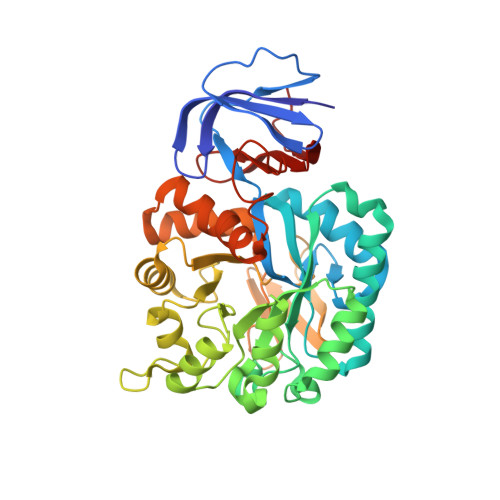The Three-Dimensional Structure of the N-Acetylglucosamine-6-Phosphate Deacetylase from Bacillus Subtilis
Vincent, F., Yates, D., Garman, E., Davies, G.J.(2004) J Biol Chem 279: 2809
- PubMed: 14557261
- DOI: https://doi.org/10.1074/jbc.M310165200
- Primary Citation of Related Structures:
2VHL - PubMed Abstract:
The enzyme N-acetylglucosamine-6-phosphate deacetylase, NagA, catalyzes the hydrolysis of the N-acetyl group of GlcNAc-6-P to yield glucosamine 6-phosphate and acetate, the first committed step in the biosynthetic pathway to amino-sugar-nucleotides. It is classified into carbohydrate esterase family CE-9 (see afmb.cnrs-mrs.fr/CAZY/). Here we report the cloning, expression, and three-dimensional structure (Protein Data Bank code 1un7) determination by x-ray crystallography of the Bacillus subtilis NagA at a resolution of 2.0 A. The structure presents two domains, a (beta/alpha)(8) barrel enclosing the active center and a small beta barrel domain. The structure is dimeric, and the substrate phosphate coordination at the active center is provided by an Arg/His pair contributed from the second molecule of the dimer. Both the overall structure and the active center bear a striking similarity to the urease superfamily with two metals involved in substrate binding and catalysis. PIXE (Proton-Induced x-ray Emission) data show that iron is the predominant metal in the purified protein. We propose a catalytic mechanism involving proton donation to the leaving group by aspartate, nucleophilic attack by an Fe-bridged hydroxide, and stabilization of the carbonyl oxygen by one of the two Fe atoms of the pair. We believe that this is the first sugar deacetylase to utilize this fold and catalytic mechanism.
Organizational Affiliation:
Department of Chemistry, The University of York, Heslington, York, YO10 5YW, United Kingdom.

















